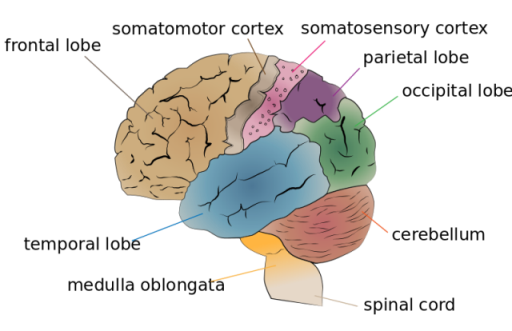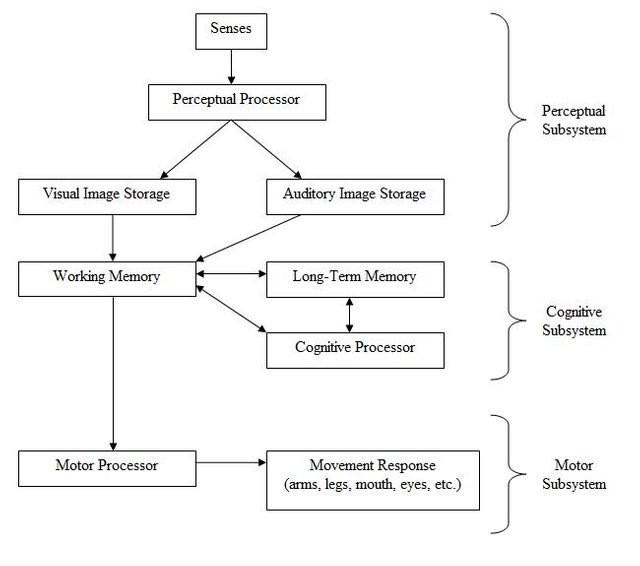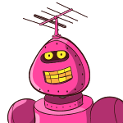Human Memory, Memory Failures and New Prosthetic Memory
As humans with a brain, we no doubt, have amazing memories. But according to our basic biology, our memories are a very unique feature of our brain. Most of the time, when we talk of our memory, we inadvertently refer to the long term memory of the brain. Our brain memory is of three major types, and functions in various phases – the sensory memory, short-term memory and long-term memory.
For things we do daily, how does our memory deal with them? Well, in the order of our day-to-day usage of our memory, we actually utilize the long-term memory. However, there are important short term memory and sensory memory processes that must be engaged and worked through, before we can establish a long-term memory.
The image below highlights the major parts of our brain used in generating the various types of memories with develop, as we carry out our day-to-day activities, running into a lifetime of memories.

The memories operate at varying levels, and cooperate in the process of memory retention, in a bid to form a lasting memory. The model or procedure of memory formation as a sequence involving the three stages is considered the Modal Memory Model and was developed in 1968 by Richard Atkinson and Richard Shiffrin. The modal model is still the most popular model for memory studies.
An alternative memory model was proposed in 1972 by Fergus Craik and Robert Lockhart, and is theorized based on the premise the memory extent is dependent on the degree of mental processing on a continuous scale from shallow to deep. The model doesn’t posit a real structure and doesn’t distinguish between short and long-term memory.
Memory Types
- Sensory Memory
This is the shortest memory element, and retains memory information less than a second after the item is perceived. Stimuli perceived from the senses of sight, touch, hearing, smell, and taste, which are retained very briefly and accurately are functions of the sensory memory. Looking at an item and remembering what it looks like in a split second is an example of sensory memory.

- Short-term Memory
Short-term memory functions like a notepad for temporarily recalling information being processed at any point. It is also considered as the ability to “remember” and “process” information at the same time. It is also known as working memory, although its capacity is very limited, and it enables recall for duration ranging from several seconds to a minute without rehearsal.
How do the short-term memory thrive? Well, the regions of the prefrontal, frontal and parietal lobes of the brain are involved in neuronal communication enabled by transient patterns which support the short-term memory.
- Long-term Memory
The long-term memory in contrast to the sensory ad short-term memory is meant for storage of information for potentially unlimited duration, regardless of our daily impressions of forgetfulness. For sensory and short-term memory information is not retained indefinitely. However, long-term memory can store much larger quantities of information sometimes for a whole life span; as its capacity is immeasurable. The long-term memories thrive via more stable and relatively permanent changes in neural connections in parts of the brain.
Also, the brain’s hippocampus area which is not used to store information, functions like a temporary transit point for long-term memories. The hippocampus helps consolidate information from short-term memories to long-term memories.

What about Memory Failures?
Time and age affects human memories. There are moments of forgetfulness or absentmindedness, which can lead to memory failures of loss. There is also the case of brain damage, injury and amnesia which cause loss of memories as well. For instance;
Forgetfulness: This occurs in long-term memories when there is an interference with an older memory. This happens when synaptic connections which were formerly strengthened among the neurons in a neural network get weakened. It can also occur when new memory network is activated and superimposed over an older network.
Absentmindedness: This is simply memory failure owing to lack of attention. When attention is not proper, then information might not be stored into long-term memory; as attention plays a key role in the process, failure of which the information might not be stored, making it rather impossible to retrieve it later.
Transience: This happens after the information has been stored and before it is retrieved. It is a state of lasting for only a short time, and can happen during sensory, short-term and long-term storage. In this state, information is forgotten in the first few days or years rapidly, followed by minimal losses in the following days or years.
Technology can now help with memory failure or losses
In a new study of technological implementation of prosthetic system, scientists at Wake Forest Baptist Medical Center and the University of Southern California (USC) have successful applied a prosthetic system adopts a person’s brain memory patterns to encode and recall memory.
The study which is a pilot project according to lead author of the study, Wake Forest Baptist’s professor of physiology/pharmacology and neurology, Robert Hampson, focused on improving the brain’s episodic memory, which represents the memory loss type common in Alzheimer’s disease patients, and people with stroke and head injury. Episodic memory represents new information that is useful for a short period of time, such as where you dropped your house key on a given day, while a reference memory is information held and used for a long time; example could be what is learned in school or church.
The scientists worked with epilepsy patients at Wake Forest Baptist, eight of whom were part of a brain-mapping procedure to detect origin of their seizures, using surgically implanted electrodes placed in parts of their brain. With the aid of the team’s electronic prosthetic system, the scientists influenced multiple neurons in the hippocampus which is involved in producing new memories.
The researchers then recorded the neural codes and patterns of the study participants as they performed computerized memory tasks. In the first test, the participants were shown an image, after which they were asked to identify the initial image among four or five other images on the screen. The team from University of Southern California (USC) led by biomedical engineers, Theodore Berger and Dong Song analyzed the correct responses and synthesized a multi-input multi-output (MIMO) base code for the right responses. The participating subjects displayed a 37 percent improvement in their performance over a baseline. In a second test, involving a distinctive photographic recognition, the study participants displayed a 35 percent improvement in memory over baseline, when their memory was stimulated with the correct-answer codes.
Conclusion
The new pilot brain and memory boost is considered a successful human clinical trial, and is seen as a potential means of assisting people with impaired memories due to sickness, aging or accidents, hold on to special memories, such as where they reside, what their loved ones look like, and other essentially related memory, even when their overall memory begins to fail.
The study has shown that it is possible to use electronic prosthetic system based on a multi-input multi-output (MIMO) nonlinear mathematical model to identify the neural firing codes or patterns that indicate correct memory formation; and subsequently separate the correct patterns from the incorrect patterns.
According to Professor Hampson, the animal testing stage of the study applied the same type of stimulation in the brain to restore and facilitate the animal’s memory, and the successful human trial shows that the procedure can help feed in the correct patterns to assist a patient's brain in accurately forming new memories. The procedure is not considered a replacement for natural memory function, but acts as a boost to it.
References & Further Reading
Thank you for your time and for reading my post.
If you found this post interesting, then kindly UPVOTE, RESTEEM and FOLLOW @rickie, for more quality posts.

Nice one @rickie
Well, I also have started loosing my memory...😁 no wonder what will happen when I reach 60's.....may be then I can use this system.
Cheers
Lolz.....@vinamra. I doubt you would ever have memory issues anytime soon. You are simply too health-wise and health conscious for that to happen anytime soon. Thanks for reading.
Prosthetic memory? Sounds like a welcome idea for people with memory inadequacy. Technology has really come a long way to give humans some boost.
Nice piece man
Yea, you are right @samminator. It'd be a great boost for some many folks with memory failures. Thanks for reading.
Thanks for this, so very interesting observations about the workings of our complex minds! Its amazing really when you think about where and how our thoughts come from, are we the thinkers, or conduits for something higher like antennas? On a slightly different note I know there is a lack of iodine right now which can effect brain functioning, its good to supplement with iodine for optimum brain health.
Well, our brains have a dynamic trend. As for whether we are conduits for something higher or we are thinkers, ourselve. I wouldn't exactly know for certain....lolz. Perhaps, the future would reveal the unknown of today. Thanks for reading @tonysayers33
Hello! I find your post valuable for the wafrica community! Thanks for the great post! @wafrica is now following you! ALWAYs follow @wafrica and use the wafrica tag!
Congratulations! Your post has been selected as a daily Steemit truffle! It is listed on rank 13 of all contributions awarded today. You can find the TOP DAILY TRUFFLE PICKS HERE.
I upvoted your contribution because to my mind your post is at least 10 SBD worth and should receive 59 votes. It's now up to the lovely Steemit community to make this come true.
I am
TrufflePig, an Artificial Intelligence Bot that helps minnows and content curators using Machine Learning. If you are curious how I select content, you can find an explanation here!Have a nice day and sincerely yours,

TrufflePigThere are many classifications of memory, in fact if you wanted to take it by sensory memory, which corresponds to the procedural (of learning) and perceptual memory. likewise there is declarative and non-declarative, as well as episodic and spatial. These types of memory have their basis in structures of the nervous system point, even the procedural is controlled by the frontal lobe, all of them effectively develop a neural network. Each of the aforementioned help us specialists in the learning process and effectively in the classification of disorders
Thank you for sharing this information. I hope that the testing is successful. My mother has Parkinson's Dementia, which as I understand it caused by the Parkinson's interfering with the retrieval process. The memories are there, but accessing them is problematic. Sometimes we can use prompts to jump start the memory retrieval.
For example my Mom frequently worries about her mothers well being. I ask her where does Nana live? She responds in heaven with God. This stops her from worrying about Nana. We are just using the question as a prompt to retrieve the information, using a different neural path.